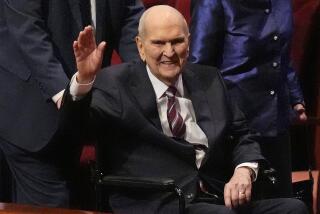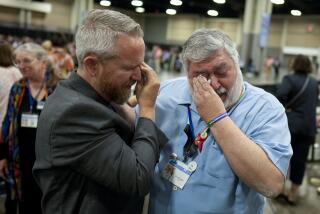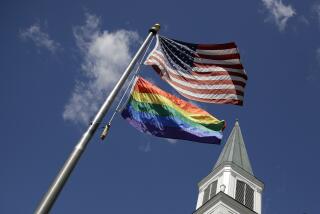United Methodists Search for Ways to Reverse Erosion of Membership
- Share via
NASHVILLE, Tenn. — Membership in the United Methodist Church, the nation’s second largest Protestant body, has been eroding annually for two decades, but only now are church leaders talking seriously about reversing the trend.
The denomination two years ago hastily adopted a goal of reaching 20 million members--double its current membership--by 1992. Some church officials now acknowledge that this target was “debilitating as a true goal,” and the current aim is merely to halt the slide and show some modest gains in a year or two.
Some major obstacles to achieving even that turnaround were cited recently by Arkansas Bishop Richard B. Wilke, who chairs a special membership growth committee. In a speech to the Methodists’ biennial Congress on Evangelism held here last week, Wilke pointed out that:
- Sunday school attendance is half of what it was two decades ago.
- Two-thirds of the 38,000 churches do not have confirmation or membership classes.
- In 1984, one-third of the congregations failed to baptize a single new member.
‘Full of Nostalgia’
“We’re tired, listless, full of nostalgia for earlier days,” Wilke said.
And a new membership figure also shows that the total has dropped for the 21st straight year--down 64,000 to 9,228,000 by the end of 1984. The new total, provided by the denomination’s Nashville-based Board of Discipleship, is unofficial but virtually complete from reports by regional conferences.
Figures from 1985 are expected to be no better and it would be “a miracle of God,” to use Wilke’s words, if Methodists can stop the slide this year.
“There would be a great sweep of joy and enthusiasm go through the United Methodist Church and most of Christendom if we could just turn the ship around,” Wilke said.
More is at stake than raw numbers. In the early 1960s, the Methodists seemed to epitomize a middle-of-the-road Christianity that was increasingly attuned to civil rights and other social issues. At the time, the Southern Baptists, the new rival in size, did not seem destined for the religious mainstream.
Southern Baptists Surge
Things have changed remarkably since then. The Methodists and other mainstream denominations ebbed and the Southern Baptist Convention, now 14.3 million members strong, led a conservative Protestant wave that coincided with the presidential elections of Jimmy Carter, a Southern Baptist, and Ronald Reagan, a favorite of the religious right.
“We paid a price to be faithful to certain dimensions of the Bible,” Wilke said, referring to the United Methodist struggles to promote racial integration and women’s rights and to oppose the Vietnam War and the nuclear arms race.
Some studies have disputed a common belief that church involvement in controversial social issues contributed to an exodus from mainstream denominations. Some observers have claimed that Methodist emphasis on social and political issues shifted attention away from church growth and evangelism.
As part of its new outreach program, United Methodist bishops this month began polling their churches on church growth practices and the denomination launched its first entry into religious television.
‘Growth Inventory’
Local churches are being asked by bishops to fill out and return by the end of January a “growth inventory” of existing classes and membership goals. Rather than suggesting goals and programs to the churches, the bishops say they are encouraging local congregations to come up with their own ideas.
Earlier, Bishop Jack Tuell of the California-Pacific Conference, sent a survey to pastors in Southern California and Hawaii about the frequency of their personal visits with ailing members, prospective members and people seeking counseling. “The range so far has been as low as three calls a week to as high as 40,” Tuell said.
“I think there is some relationship between a lower priority for this kind of work and lowered numbers,” said Tuell, whose office is in Pasadena.
Part of the problem for mainstream denominations, Tuell added, is that “people are not excited about their faith. Going to worship for many is not the exciting thing it ought to be in a growing vital church.”
‘Catch the Spirit’
One effort to stir excitement was the start on Jan. 4 of “Catch the Spirit,” a half-hour, magazine-format television series being shown on four cable networks, including the large Christian Broadcast Network.
Methodist communications officials have apologized to congregations for the mostly early-morning time slots, and they have asked members to urge local channels to air the program at better times when contracts are renewed in the fall.
The slogan “Catch the Spirit” was first used by Methodists in Tennessee and is now being used throughout the denomination by both local churches and national church agencies to represent what they hope is a new enthusiasm.
Whatever excitement and evangelism is generated in coming years is nevertheless likely to be tempered by a Methodist sense of balance.
“The United Methodists believe that it is possible to be fervent, enthusiastic and have intellectual integrity at the same time,” said H. Eddie Fox, assistant general secretary of the Board of Discipleship.
Woman, Black to Co-Host
The characteristic Methodist attention to minority representation in church organizations is reflected in the choice of a woman and a black minister as co-hosts for the “Catch the Spirit” television program. Both have television acting experience.
The drive to put more minorities in Methodist leadership positions has had more to do with a sense of Christian integrity than with recruitment among racial and ethnic communities. Indeed, between 1974 and 1982, Wilke said, the number of black Methodists increased only about 1% and Latino membership made minimal gains. Asian-heritage churches, mostly Korean, made a 127% jump in membership in that period.
Methodists can be expected to continue to encourage multiethnic membership within individual churches. This contrasts with another theory which says that the fastest-growing congregations will be those that are homogeneous in culture and socioeconomic character.
Methodist minister W. James Cowell, the Nashville-based director for congregational development, said he has some reservations about what is known as the church growth movement.
“Obviously, we are developing ethnic churches because of the language problem, but otherwise, if we are going to be Christian people, we should be helping them to break down other barriers,” Cowell said.
Clarify Commitment
“The other concern I have is that churches in the church growth movement have a tendency not to address tough social problems,” he added. “Our commitment is not only to saving souls but to the social dimensions of Christian life in the world.”
Wilke, the membership campaign chairman, and social scientist Warren Hartman, who handles church statistics for the Board of Discipleship here, are convinced that figures must improve in Christian education, or Sunday school, attendance and enrollment before membership totals will start to rise.
A former Wichita, Kan., pastor who doubled his own church classes from 500 to 1,000, Wilke said church school attendance among Methodists declined from 4 million in 1964 to 2 million in 1984. (Both Wilke and Hartman combined the totals of the Methodist Church and the relatively small Evangelical United Brethren before 1968 when the two churches merged to form the United Methodist Church.
“The church school is where we need to give our utmost attention,” Wilke said. “Only if the church is revived, and revitalized with a lot of new wrinkles . . . will we turn it around. We still haven’t had improvement in Sunday school figures, which precede membership trends by about three years.”
More to Read
Sign up for Essential California
The most important California stories and recommendations in your inbox every morning.
You may occasionally receive promotional content from the Los Angeles Times.













